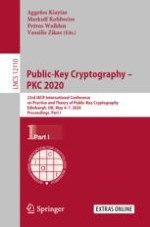2020 | OriginalPaper | Buchkapitel
Bringing Order to Chaos: The Case of Collision-Resistant Chameleon-Hashes
verfasst von : David Derler, Kai Samelin, Daniel Slamanig
Erschienen in: Public-Key Cryptography – PKC 2020
Aktivieren Sie unsere intelligente Suche, um passende Fachinhalte oder Patente zu finden.
Wählen Sie Textabschnitte aus um mit Künstlicher Intelligenz passenden Patente zu finden. powered by
Markieren Sie Textabschnitte, um KI-gestützt weitere passende Inhalte zu finden. powered by
